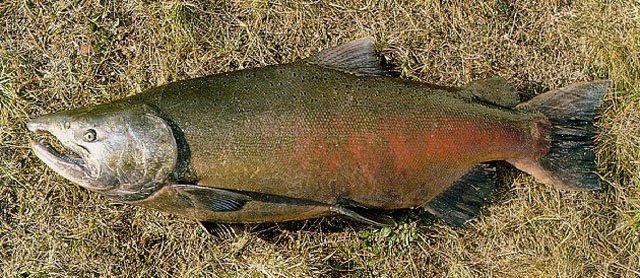| Salmonidae (Salmonids), subfamily: Salmoninae |
| 150 cm TL (male/unsexed); max.weight: 61 kg; max. reported age: 9 years |
|
benthopelagic; freshwater; brackish; marine; depth range 0 - 375 m, anadromous |
| Arctic, Northwest to Northeast Pacific: drainages from Point Hope, Alaska to San Joanquin and King rivers in California, USA (Ref. 86798). Also in Honshu, Japan (Ref. 6793), Sea of Japan (Ref. 1998), Bering Sea (Ref. 2850) and Sea of Okhotsk (Ref. 1998). Found in Coppermine River in the Arctic. Several countries report adverse ecological impact after introduction. |
|
Dorsal spines (total): 0-0; Dorsal soft rays (total): 10-14; Anal spines: 0-0; Anal soft rays: 13-19; Vertebrae: 67-75. Distinguished by the small black spots on the back and on the upper and lower lobes of the caudal fin, and the black gums of the lower jaw (Ref. 27547). Body fusiform, streamlined, noticeably laterally compressed in large adults, somewhat deeper than other species (Ref. 6885). Gill rakers wide-spaced and rough; pelvic fins with axillary process (Ref. 27547). Fish in the sea are dark greenish to blue black on top of head and back, silvery to white on the lower sides and belly; numerous small, dark spots along back and upper sides and on both lobes of caudal; gum line of lower jaw black (Ref. 27547). In fresh water, with the approach of the breeding condition, the fish change to olive brown, red or purplish, the color change being more marked in males than in females (Ref. 27547). |
| Adults return to natal streams from the sea to spawn (Ref. 27547). Fry may migrate to the sea after only 3 months in fresh water, some may stay for as long as 3 years, but generally most stay a year in the stream before migrating (Ref. 27547). Some individuals remain close inshore throughout their lives, but some make extensive migrations (Ref. 27547, 44894). Also found in lakes (Ref. 1998). Possibly up to 375 m depth (Ref. 6793). Epipelagic (Ref. 58426). Food in streams is mainly terrestrial insects and small crustaceans; in the sea, major food items include fishes, crustaceans, and other invertebrates (Ref. 27547). Young are preyed upon by fishes and birds (such as mergansers and kingfishers); adults are prey of large mammals and large birds (Ref. 1998). Highly regarded game fish (Ref. 27547). Flesh is usually red, but some are white; the red meat commands a higher price (Ref. 27547). Marketed fresh, smoked, frozen, and canned. Eaten steamed, fried, broiled, boiled, microwaved, and baked (Ref. 9988). Viscera said to contain high vitamin A content and used successfully as food for hatchery fish (Ref. 28971, 28977). |
|
Least Concern (LC); Date assessed: 18 September 2020 (Least Concern) Ref. (130435)
|
| potential pest |
Source and more info: www.fishbase.org. For personal, classroom, and other internal use only. Not for publication.
